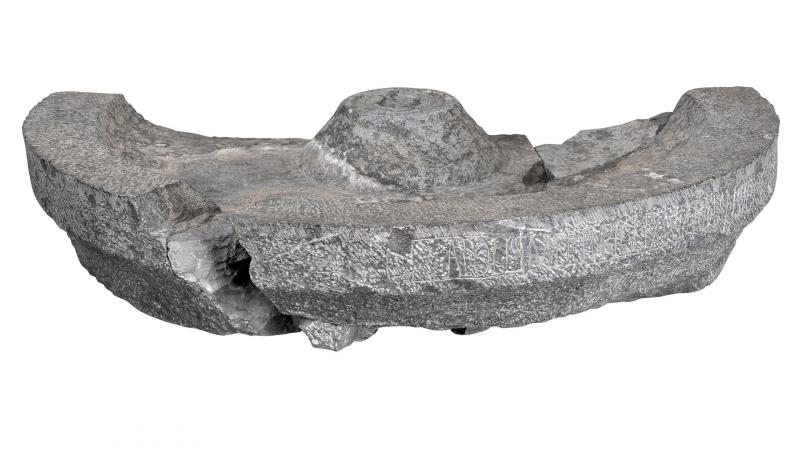Work classified as a treasure by the Wallonia-Brussels Federation
The blue limestone basin, classified as a "treasure" by the Wallonia-Brussels Federation on 8 March 2017, was unearthed during an excavation campaign carried out between 2003 and 2005 by archaeologists from the Wallonia Public Service (Liège Directorate - Archaeology), on land belonging to the Saint-Amand church factory in Jupille-sur-Meuse.
The object, which dates back to the 2nd century AD, was buried in the preparatory layer of an exterior floor, in front of the eastern façade of one of the most important public buildings of the ancient town: the sanctuary (fanum).
The dedicatory inscription Apoll(ini) Smerturici Exsuper Mansueti f(ilius), set in a tabula ansata (cartouche flanked by dovetails) is of great interest: it tells us the name of the sanctuary's tutelary deity: Apollo, worshipped in his local form (Smerturix means "the provider, the protector") as a healing god or god of purification, and gives us the name of the dedicator, a peregrine (free inhabitant not holding Roman citizenship) named Exsuper, son of Mansuetus.
The basin probably served the faithful who wished to perform a purification rite before invoking the divinity.
Apoll(ini) Smerturigi Exsuper Mansueti f(ilius)
The inscription in a cartouche (tabula ansata) means 'For Apollo Smerturix, Exsuper, son of Mansuetus (offered this basin)'. In Jupilla, Apollo was worshipped in his local form (Apollo Smerturix means 'Apollo the provider, the protector') as a healing god or god of purification.
More about the Treasures of the Wallonia-Brussels Federation
The decree of 11 July 2002 makes it possible to classify as a Treasure, goods that are of notable interest to the Wallonia-Brussels Federation. Within this framework, several works whose artistic quality, rarity or links with the history and history of art are no longer in question, are further enhanced by this classification. This recognition makes it possible to highlight these jewels of our artistic and cultural heritage, but above all to better protect them, to help restore them or to prevent them from being sold abroad. Several major historical works are recognised as Treasures each year.
A protected property is given the status of "treasure". This term originates from European law, which offers each Member State the possibility of protecting its "national treasures of artistic, historical or archaeological value". These treasures are therefore exempt from the principle of free movement of goods within the European Union and may be subject to restrictions or bans on leaving the national territory concerned.
More information on the website of the Wallonia-Brussels Federation.
